Guía de Machu Picchu 2025: Todo lo que necesitas saber
He aquí una guía actualizada de 2025 sobre Machu Picchu, donde personas de todo el mundo se aventuran a compartir una dosis de asombro y despertar. Esta completa guía lo abarca todo, desde los circuitos y mapas de Machu Picchu hasta las visitas guiadas, entradas e información esencial para el visitante.
Ninguna fotografía o descripción puede captar la experiencia. Debes asistir a ese momento en el que contemplas por primera vez la monumental arquitectura inca perfectamente encaramada entre dos escarpados picos montañosos. Ahora lee esta guía de Machu Picchu para 2025.
Horarios y Circuitos para visitar Machu Picchu en 2025
¿Dónde está Machu Picchu?
El Santuario de Machu Picchu está situado a 73 km (45 millas) de la Plaza de Armas de Cuzco, Perú, Sudamérica. El núcleo de población más cercano -y principal puerta de acceso a la antigua ciudadela- es el pueblo de MachuPicchu Pueblo, más conocido como Aguas Calientes. No hay acceso directo por carretera a esta pequeña y bulliciosa ciudad, por lo que la única forma de llegar a ella es en tren o a pie. La entrada principal a Machu Picchu se encuentra a 2.438 metros sobre el nivel del mar, en la cima de la montaña de Aguas Calientes.
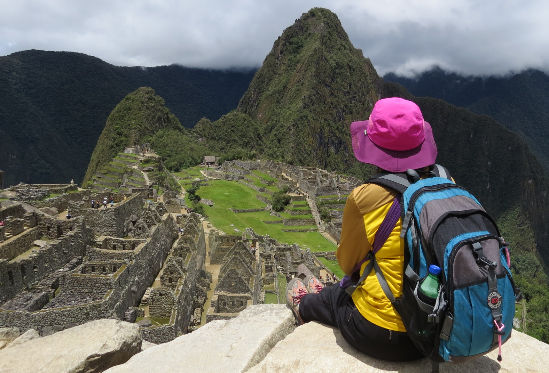
[su_button url=»https://www.fertur-travel.com/es/peru-packages/» target=»blank» style=»default» background=»#335CA6″ color=»#FFFFFF» size=»5″ wide=»no» center=»yes» radius=»auto» icon=»» icon_color=»#FFFFFF» text_shadow=»none» desc=»» onclick=»» rel=»» title=»» id=»» class=»»]Ver Todos los Paquetes Turísticos[/su_button]
¿Cuánto se tarda en subir a Machu Picchu?
Para subir al santuario, puedes elegir entre una caminata de 75 minutos a 2 horas (la duración depende de tu forma física) o subir a uno de los autobuses que salen de Aguas Calientes cada cinco minutos entre las 5.30 y las 15.30 horas. Los autobuses tardan unos 25 minutos en ascender por la carretera sinuosa de Hiram Bingham. Los billetes para el autobús se venden junto al lugar de salida de los vehículos, pero a menudo hay largas colas. Además, las entradas Machu Picchu NO se venden en la puerta de entrada de arriba.
Comprar los boletos de ingreso a Machu Picchu en persona el día anterior
Hay una oficina del Ministerio de Cultura junto a la plaza principal de Aguas Calientes (Machupicchu Pueblo) donde se puede comprar un número limitado de entradas con un día de antelación, entre las 15.30 y las 22.00 horas. Puedes entrar en Internet para reservar estos billetes con 48 horas de antelación, según disponibilidad.
Pero comprarlos así, a última hora, no es aconsejable. Las entradas pueden agotarse con días de antelación o, durante la temporada de mayor afluencia (de junio a agosto), con semanas. Por eso es conveniente comprar con bastante antelación tanto el billete de autobús hasta el santuario como la entrada a la ciudadela. Los visitantes también pueden consultar la disponibilidad y comprar entradas en el sitio web oficial de Machu Picchu.
Reserva Machu Picchu en 2025
[su_accordion class=»chevron-circle-accordion»] [su_spoiler title=»¡Haz clic aquí para personalizar tu tour a Machu Picchu ahora!» open=»no» style=»fancy» icon=»chevron-circle» anchor=»» class=»»] Para reservar tus tours a Cusco ahora o consultarnos, completa este formulario de contacto y un coordinador de Fertur Peru Travel se pondrá en contacto contigo dentro de un día hábil con información detallada sobre tu viaje completamente personalizable.
¿Cuáles son los horarios de entrada a Machu Picchu?
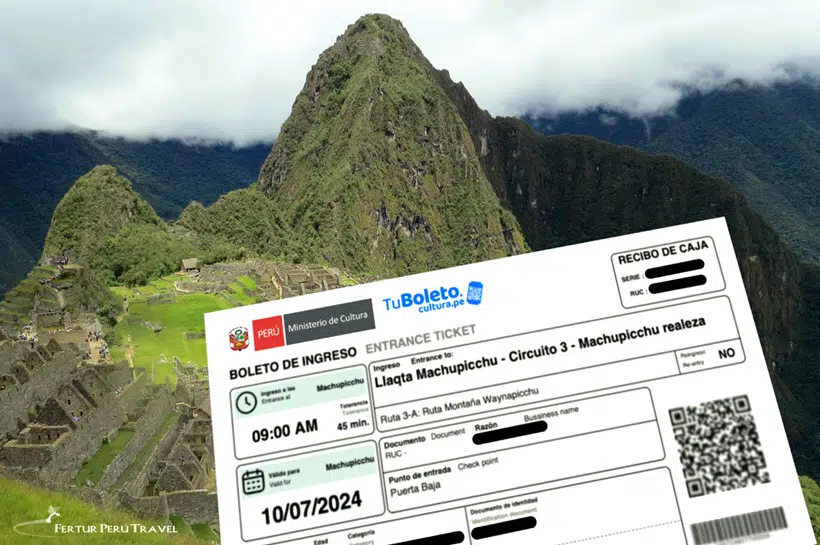
Los horarios actualizados de entrada a Machu Picchu en 2025 están estructurados para agilizar y gestionar eficazmente el flujo de visitantes a fin de minimizar el impacto del tráfico peatonal. El recinto está abierto todos los días de 6.00 a 17.00 horas, con franjas horarias de entrada específicas cada hora hasta la franja horaria de las 15.00 horas.
Cada entrada tiene una ventana de 1 hora para entrar, y hay un periodo de tolerancia de 45 minutos para entrar por la puerta principal.
Límites diarios de visitantes y disponibilidad de entradas a Machu Picchu
El número máximo de visitantes al día es de 4.500 en temporada baja y de 5.600 en temporada alta (del 1 de junio al 15 de octubre).
Mil de esas entradas están a la venta diariamente, en persona, en Machupicchu Pueblo (Aguas Calientes), el pueblo situado debajo de Machu Picchu. Se venden por orden de llegada y sólo pueden adquirirse un día antes de la entrada. Sin embargo, te recomendamos encarecidamente que compres los billetes con bastante antelación a tu viaje.
¿Es obligatorio un guía de Machu Picchu?
Los visitantes deben ir acompañados de un guía titulado*, en privado o en pequeños grupos, para entrar en el santuario y recorrer una de las cuatro rutas establecidas. Además, los visitantes pueden elegir con antelación comprar entradas para subir a la montaña Machu Picchu, a la montaña Huchuypicchu o al emblemático pico de Huayna Picchu.
*Nota: La norma que exige que los visitantes vayan acompañados de un guía titulado se aplica estrictamente a los grupos. Sin embargo, la normativa no se aplica actualmente en la práctica a los turistas individuales. Los visitantes pueden recorrer la Ciudadela Inca sin guía, aunque es muy recomendable tener uno.
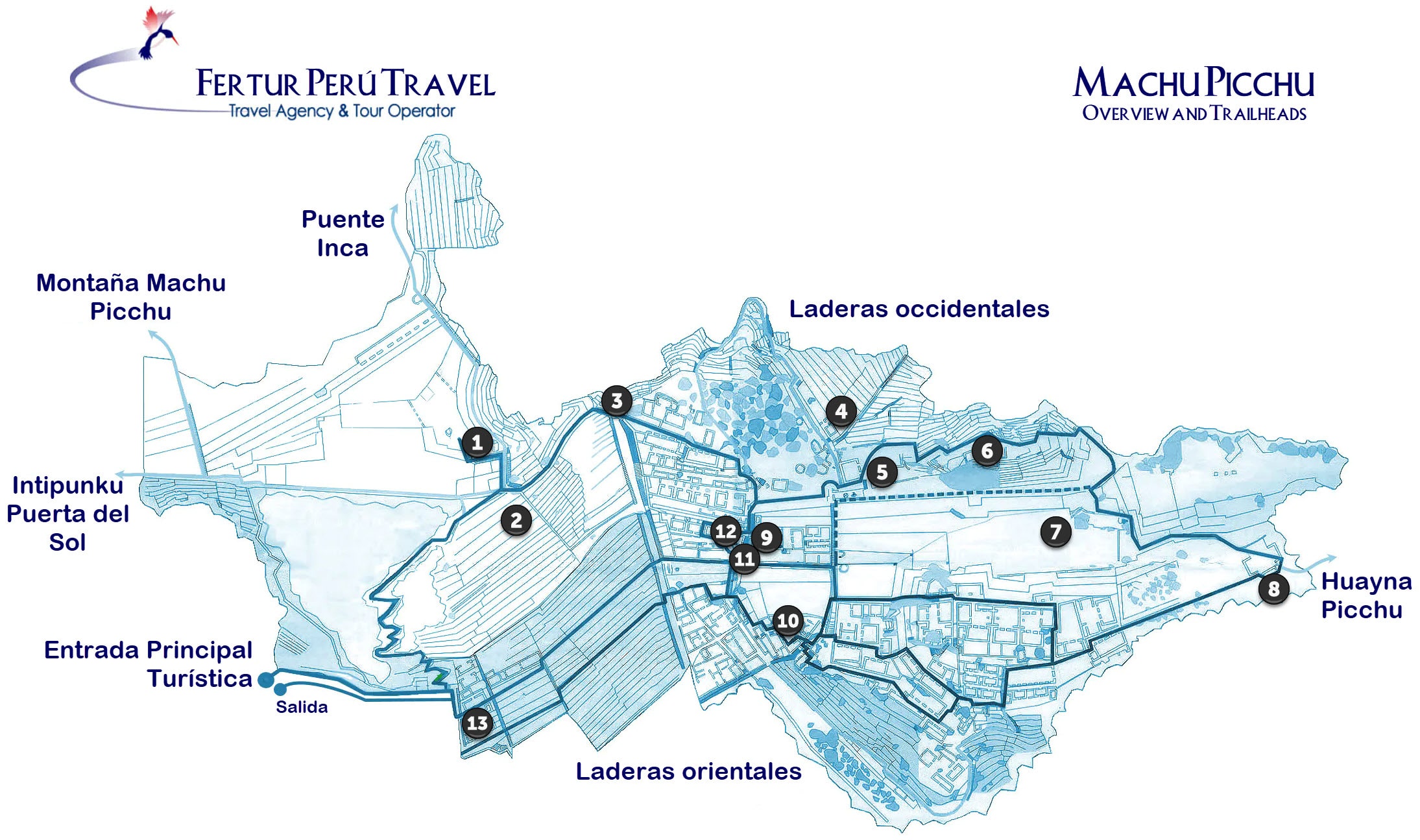
Puntos de interés:
- Caseta de vigilancia
- Zona agrícola
- Puerta principal
- Zona Agrícola Oeste
- Templo de las Tres Ventanas
- Intihuatana
- Plaza Mayor
- Roca sagrada
- Cerramientos reales
- Templo del Cóndor
- Fuentes
- Torre
- «Casas de almacenamiento «Qollca
Mapa y rutas del Circuito Machu Picchu
A partir del 1 de junio de 2024, Machu Picchu introducirá nuevos circuitos turísticos para organizar mejor el tráfico de visitantes y preservar el yacimiento arqueológico. Ahora hay tres circuitos principales, cada uno con múltiples subrutas, que suman un total de 10 opciones diferentes:
Circuito Machu Picchu nº 1 (Circuito Panorámico) – Rojo:
[su_accordion class=»plus-icon-accordion»] [su_spoiler title=»Haz clic para abrir el Mapa del Circuito 1 de Machu Picchu» open=»no» style=»fancy» icon=»plus» anchor=»» class=»»] 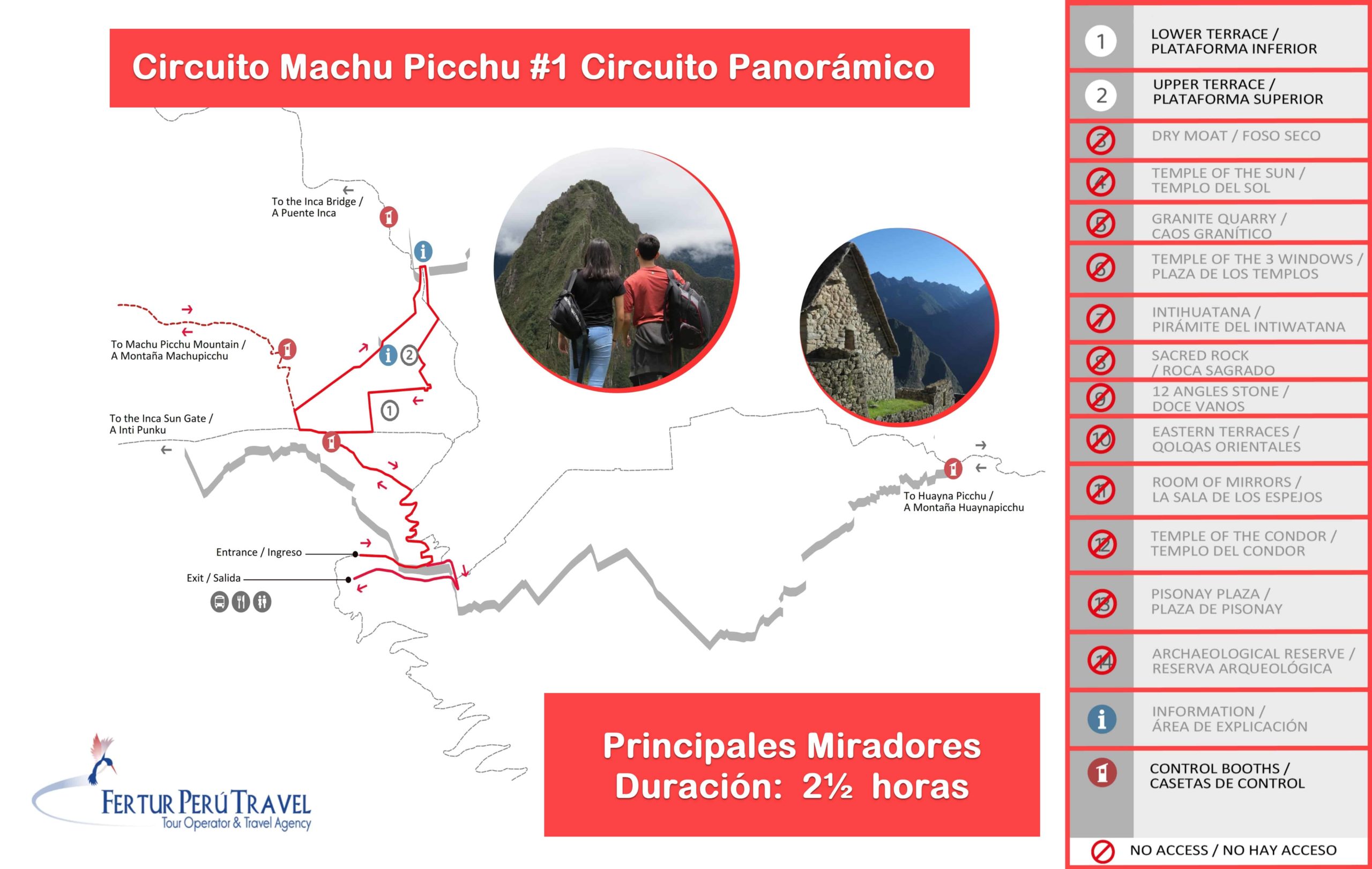
Este breve itinerario incluye las terrazas superiores cercanas a la cabecera del camino a la Montaña de Machu Picchu y la Puerta del Sol, seguidas del Portal Principal, la Cantera de Granito, la Sala de los Espejos y las Fuentes Ceremoniales.
Este circuito ofrece las vistas más panorámicas, pero no incluye el acceso a las partes bajas del lugar.
- Ruta 1-A: Terraza Superior + Montaña Machu Picchu (4-6 horas)
- Incluye: Andén inferior, Andén superior, Montaña Machu Picchu
- Ruta 1-B: Terraza Superior (único mirador principal) (2,5 horas)
- Ruta 1-C: Terraza Superior + Intipunku (Puerta del Sol) (3 horas)
- Incluye: Visita a Tambo y Pachamama (sólo en temporada alta)
- Ruta 1-D: Terraza Superior + Puente Inca (2 horas)
- Incluye: Vista del Valle de Vilcanota (sólo en temporada alta)
Circuito Machu Picchu nº 2 (Circuito Ciudad Inca) – Azul:
[su_accordion class=»plus-icon-accordion»] [su_spoiler title=»Haz clic para abrir el Mapa del Circuito 2 de Machu Picchu» open=»no» style=»fancy» icon=»plus» anchor=»» class=»»] 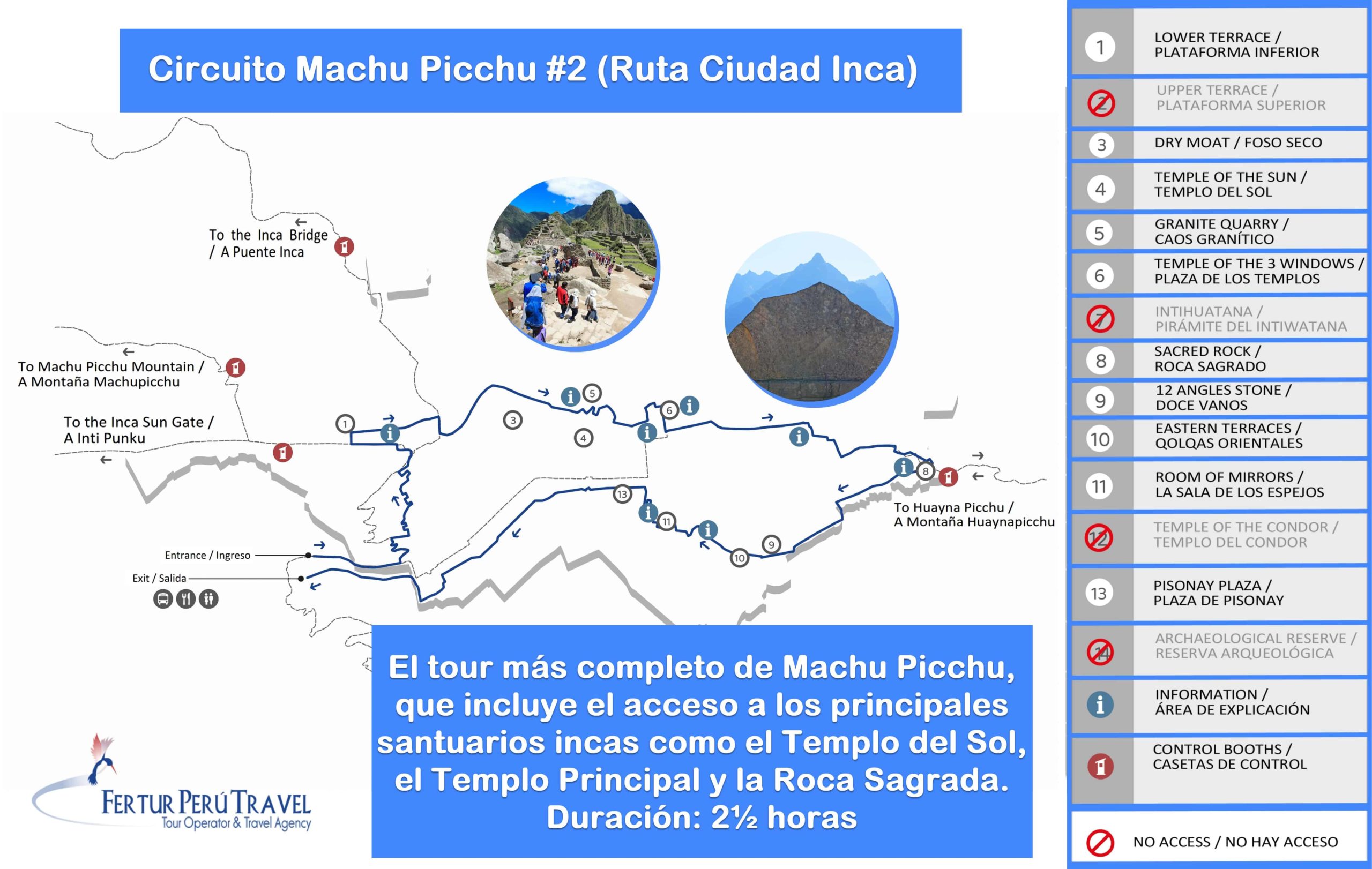
Ésta es la ruta más larga, así como el circuito más completo y popular. Incluye las terrazas superiores (o Qolqas) cerca de los caminos de acceso a la Montaña Machu Picchu y a la Puerta del Sol Inti punku, seguidas del Portal Principal, la zona de la Cantera de Granito, la Plaza Mayor Sagrada, el Intihuatana (cerrado temporalmente a los turistas por mantenimiento de conservación), la Roca Sagrada, la Sala de los Espejos y el Templo del Cóndor.
Este circuito ofrece la vista clásica de Machu Picchu y acceso a los principales elementos arqueológicos.
- Ruta 2-A: Ruta Diseñada (Clásica) (2,5 horas)
- Incluye: Mirador Principal, Cantera de Granito, Plaza del Templo, Roca Sagrada, Piedra de los Doce Ángulos, Qolqas Orientales, Complejo de Espejos de Agua, Plaza de Pisonay
- Ruta 2-B: Ruta de la Terraza Inferior (Clásica) (2,5 horas)
- Incluye: Mirador del Templo del Sol, Plaza del Templo, Roca Sagrada, Piedra de los Doce Ángulos, Qolqas Orientales, Complejo de los Espejos de Agua, Plaza de Pisonay
Estas rutas ofrecen la visita más completa de Machu Picchu, incluido el acceso a los principales lugares incas, como el Templo del Sol, el Templo Principal y la Roca Sagrada.
Circuito Machu Picchu nº 3 (Circuito de la Realeza) – Amarillo:
[su_accordion class=»plus-icon-accordion»] [su_spoiler title=»Haz clic para abrir el Mapa del Circuito 3 de Machu Picchu» open=»no» style=»fancy» icon=»plus» anchor=»» class=»»] 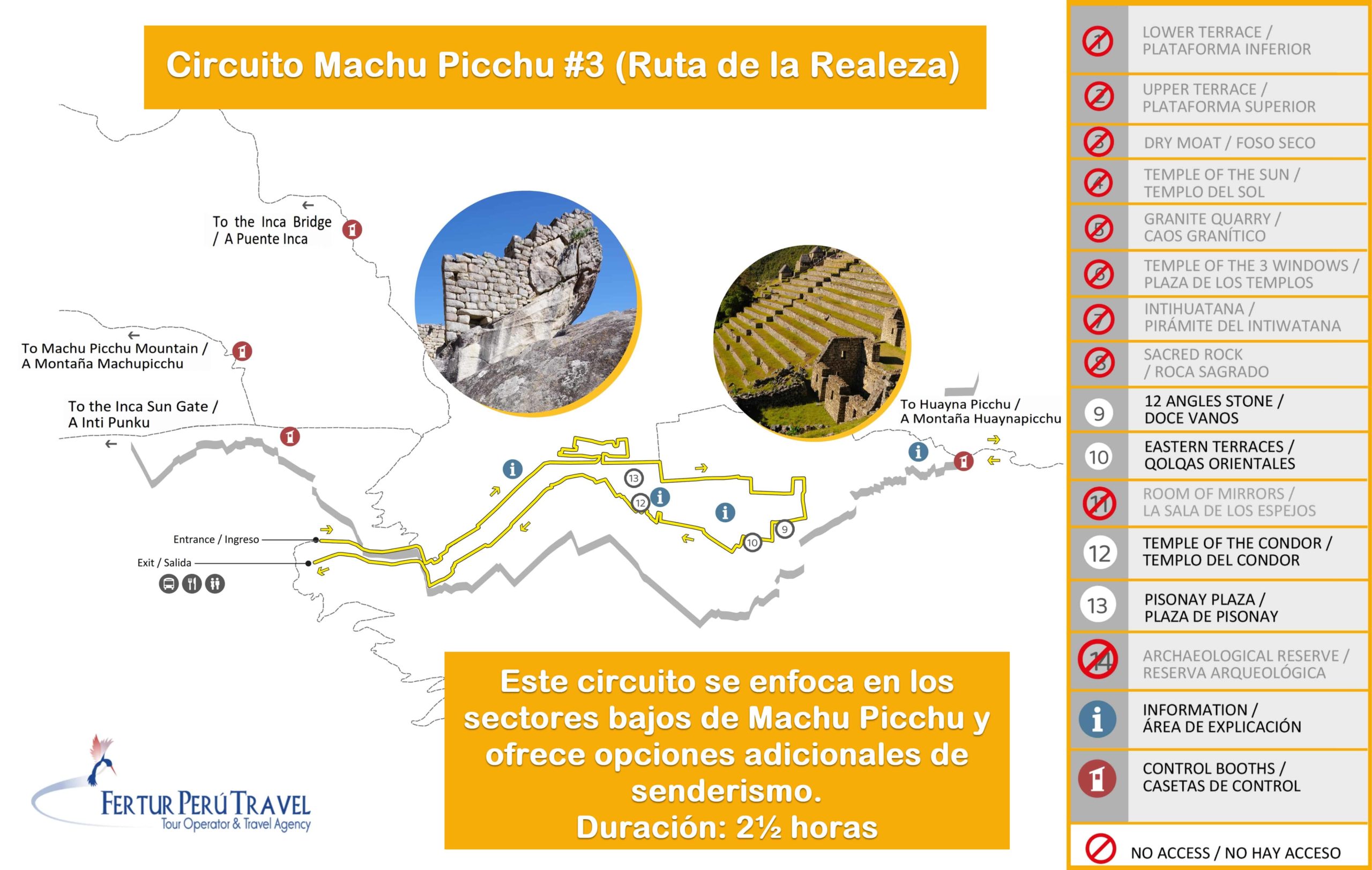
Ruta corta por la Terraza Inferior: Incluye la entrada a la Casa del Guarda, un paseo por los andenes inferiores (o Qolqas), pasando por el Templo del Sol, la Casa del Inca, las Fuentes Ceremoniales y la Sala de los Espejos.
Este circuito se centra en la parte baja de Machu Picchu e incluye opciones de senderismo adicionales.
- Ruta 3-A: Centro Arqueológico + Montaña Huayna Picchu (3 horas adicionales para la montaña)
- Ruta 3-B: Centro Arqueológico (Ruta Diseñada) (2,5 horas)
- Ruta 3-C: Centro Arqueológico + Templo de la Luna (Gran Caverna) (4 horas) (sólo en temporada alta)
- Ruta 3-D: Centro Arqueológico + Huchuy Picchu (3,5 horas) (sólo en temporada alta)
Todas las opciones de la Ruta 3 incluyen: Roca Sagrada, Piedra de los Doce Ángulos, Qolqas Orientales, Templo del Cóndor, Plaza Pisonay
Los visitantes deben elegir su ruta preferida al comprar los billetes. Cada circuito tiene precios y franjas horarias diferentes. Algunas rutas, sobre todo las que incluyen excursiones de montaña, sólo están disponibles durante la temporada alta (del 1 de junio al 15 de octubre).

Horarios de entrada específicos para las excursiones a Machu Picchu
- Para las entradas que incluyen excursiones, hay ventanas de entrada adicionales:
- Machu Picchu + Huayna Picchu:
- Entrada a partir de las 7:00 AM / Caminata de 8:00 AM a 9:00 AM
- Entrada a partir de las 8:00 / Caminata de 9:00 a 10:00
- Entrada a partir de las 9:00 / Caminata de 10:00 a 11:00
- Entrada a partir de las 10:00 / Caminata de 11:00 a 12:00
- Machu Picchu + Montaña:
- Entrada a partir de las 7:00 AM / Caminata de 8:00 AM a 9:00 AM
- Entrada a partir de las 9:00 / Caminata de 10:00 a 11:00
- Machu Picchu + Huchuy Picchu:
- Entrada a partir de las 7:00 AM / Caminata de 8:00 AM a 9:00 AM
- Entrada a partir de las 8:00 / Caminata de 9:00 a 10:00
- Entrada a partir de las 9:00 / Caminata de 10:00 a 11:00
- Entrada a partir de las 10:00 / Caminata de 11:00 a 12:00
- Entrada a partir de las 11:00 / Caminata de 12:00 a 13:00
- Machu Picchu + Puente Inca:
- Entrada a partir de las 7:00 AM / Caminata de 8:00 AM a 9:00 AM
Machu Picchu Caminatas y Atracciones Adicionales
Huayna Picchu
El nombre Huayna Picchu en quechua significa «montaña nueva». Se eleva a 2.671 metros (8.763 pies) sobre el nivel del mar, la cumbre está ceñida por edificios incas, terrazas y un santuario en el extremo inferior, el Templo de la Luna. Llegar a la cima lleva entre 50 minutos y una hora y requiere un ascenso espeluznante y difícil por un estrecho sendero y a través de un túnel en una cueva. Los empinados escalones de granito de la cima te sitúan literalmente al borde del abismo. La caminata parte de la Roca Sagrada, en el extremo norte del santuario. Sólo se admiten 200 visitantes al día, en cuatro turnos: el primero, de 6:00 a 7:00 h.; el segundo, de 8:00 a 9:00 h.; el tercero, de 10:00 a 11:00 h.; y el cuarto, de 12:00 a 13:00 h. (Nota: Tras completar este recorrido, los visitantes no pueden volver a entrar en la ciudadela).
Montaña Huchuy Picchu
Su nombre en quechua, Huch’uypicchu, significa «Pequeña Montaña». Alcanzando una altura de 2.496 metros (8.188 pies) sobre el nivel del mar, eso es exactamente lo que es este pico, situado diminutivamente junto al imponente Huayna Picchu. A pesar de su relativa estatura, la caminata moderada hasta la cima ofrece unas vistas impresionantes de Machu Picchu y del bosque nuboso circundante. La caminata de 1,9 km (1,2 millas) dura entre 45 minutos y una hora. Desde el punto de control, la caminata da la vuelta a la ruta inferior por encima de las terrazas orientales, sube y cruza el pico y vuelve a salir por las terrazas superiores. El límite de visitantes por día es de 200, repartidos en nueve turnos a lo largo del día, con el primer horario de 6:00 a 7:00 h. y el último de 14:00 a 15:00 h.(Nota: Tras completar este recorrido, los visitantes no pueden volver a entrar en la ciudadela).
Montaña Machu Picchu
Elevándose a 3.061 metros (10.044 pies) sobre el nivel del mar, el nombre quechua de este pico más alto, en el extremo sur del santuario, significa «montaña vieja». La ascensión es técnicamente menos difícil que la del Huayna Picchu, pero la subida es más larga y no menos ardua. Llegar a la cumbre suele requerir entre 90 minutos y dos horas, o más. Pero en varios puntos del camino, esta ruta ofrece vistas incomparables de la ciudadela inca enmarcada por Huayna Picchu, con el río Urubamba serpenteando a su alrededor en un recodo de herradura. Una vez en la cima, tendrás una vista panorámica de 360 grados de las montañas circundantes. La caminata comienza por encima de la Casa del Guarda, con tejado de paja, por un sendero de piedra señalizado que se desvía del camino que sube al Inti Punku. El límite de visitantes por día es de 400, también en dos turnos: el primero de 6:00 a 7:00 h. y el segundo de 8:00 a 9:00 h.
Puente Inca
Al igual que en Huayna Picchu y Machu Picchu Montaña, el inicio del sendero comienza con una caseta de vigilancia donde debes registrar tu entrada y salida. Es una caminata bastante fácil, aunque induce al vértigo. Llegar al puente lleva entre 20 y 30 minutos por un sinuoso sendero de bosque nuboso. El sendero, cada vez más estrecho, ofrece unas vistas espectaculares del valle del río y las montañas circundantes. Cruzar el Puente Inca propiamente dicho está estrictamente prohibido desde que hace varios años un excursionista lo intentó y cayó al vacío. Pero es todo un espectáculo. Cuatro troncos están colocados libremente sobre una brecha de seis metros en una sección reforzada del sendero injertada en la escarpada ladera de la montaña. Este «puente levadizo» proporcionaba a los incas un acceso controlado para evitar que huéspedes no deseados se colaran desde el valle del Aobamba, al oeste.
Inti Punku (Puerta del Sol)
Estas ruinas situadas a 2.700 metros (8.860 pies) sobre el nivel del mar mar marcan el final de la línea para los excursionistas del Camino Inca, ofreciéndoles una merecida primera vista magnífica de Huayna Picchu justo delante y de la magnífica ciudadela de piedra que se extiende por la cresta de la silla de montar que hay debajo. Los visitantes diurnos de Machu Picchu también pueden disfrutar de esta vista emblemática. Tómate entre 45 minutos y una hora para subir al Inti Punku desde el santuario, situándote a la izquierda de la caseta del guarda, a lo largo de la terraza superior.
Camino Inca Acceso a Machu Picchu
Durante años, los permisos del Camino Inca permitían a los excursionistas que llegaban a través del Inti Punku (Puerta del Sol) volver a entrar en el Santuario de Machu Picchu con acceso a las terrazas superiores. Esto nos ofreció otra oportunidad de contemplar la emblemática vista panorámica de la plaza con el Huayna Picchu al fondo, y de explorar los puntos de interés más importantes.
Eso cambió en junio de 2022 con una nueva política, limitándolas a las terrazas inferiores y a los santuarios incluidos en la Ruta 3. Los excursionistas del Camino Inca Clásico ya no tienen derecho a volver a entrar en el santuario después de salir. Los excursionistas del Camino Inca Corto desde el km 104 pueden regresar al día siguiente.
Pero para todos los excursionistas del Camino Inca, para volver a la parte superior del santuario y recorrer las Rutas 1 ó 2, deben comprar el billete de entrada adicional.
¿Qué debo llevar a Machu Picchu?
- Tu pasaporte. ¡No olvides traerla porque no podrás entrar sin ella!
- Tu billete de entrada a Machu Picchu. No hay forma de volver a emitir uno si lo olvidas o lo pierdes.
- Una cámara con la batería totalmente cargada y mucho espacio en la tarjeta de memoria.
- Buen calzado para caminar, preferiblemente zapatillas de cross o calzado diseñado para senderismo.
- Agua en una botella que no sea de plástico.
- Protector solar y gorra o sombrero.
- Un pancho para la lluvia (uno pequeño plegable está bien en caso de lluvia).
Guía de Machu Picchu 2025: ¿Qué no debo llevar? (Las normas)
Los funcionarios de Machu Picchu han señalado que se aplicarán más estrictamente las normas de conducta y una lista de objetos prohibidos promulgada desde 2017. Aquí tienes las NORMAS DE CONDUCTA y QUÉ NO LLEVAR A MACHU PICCHU
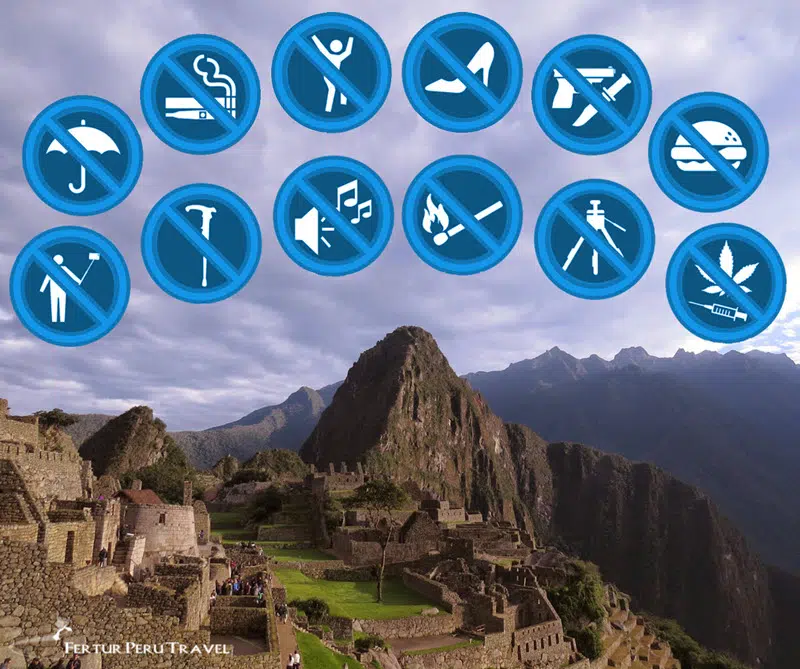
Qué hacer y qué no hacer en Machu Picchu
[su_accordion class=»plus-icon-accordion»] [su_spoiler title=»Los visitantes a Machu Picchu no están permitidos… (Haga clic para expandir)» open=»no» style=»fancy» icon=»plus» anchor=»» class=»»]
- Ingresar con botellas de plástico.
- Llevar mochilas, bolsas o carteras que superen las 16 x 14 x 8 pulgadas (40 x 35 x 20 cm). Los artículos que excedan estas dimensiones deben depositarse en la consigna fuera de la entrada.
- Ingresar con alimentos y/o utensilios.
- Ingresar con sustancias ilegales o bajo la influencia de drogas ilegales.
- Ingresar con bebidas alcohólicas o en estado de ebriedad.
- Llevar paraguas o sombrillas. (Se permiten gorras, sombreros y ponchos para la lluvia.)
- Llevar trípodes, monópodos o extensiones para cámaras, teléfonos móviles u otro equipo de estabilización o extensiones para filmación y/o fotografía, a menos que estén autorizados por el Departamento de Cultura de Cusco (DDC Cusco).
- Ingresar con animales, excepto perros guías cuando sea estrictamente necesario.
- Ingresar con cualquier tipo de aerosoles.
- Ingresar con instrumentos musicales, megáfonos o altavoces.
- Utilizar aplicaciones virtuales en teléfonos móviles o dispositivos móviles en arterias estrechas, senderos y puntos de congestión (el uso de esta tecnología está permitido solo en espacios abiertos grandes y áreas designadas para explicaciones).
- Ingresar con tacones o zapatos de suela dura (se permite el ingreso solo con zapatos o zapatillas de suela blanda o de goma).
- Ingresar con coches o carritos de bebé (solo se permiten mochilas portabebés con estructuras no metálicas).
- Ingresar con instrumentos cortantes y/o armas de cualquier tipo.
- Ingresar con pancartas, carteles y/o letreros, entre otros objetos de este tipo. (El uso de banderines está permitido exclusivamente para guías turísticos que lideren grupos de al menos 5 visitantes y se limitan al modelo y dimensiones determinados por las autoridades competentes en coordinación con los respectivos guías).
- Causar disturbios, saltar o generar desorden en el camino de entrada al Santuario de Machu Picchu y/o en cualquier punto dentro del complejo.
- Ingresar con ropa destinada a fines publicitarios.
- Escalar o apoyarse en las paredes y/o estructuras.
- Tocar, mover o extraer elementos líticos.
- Realizar cualquier tipo de graffiti.
- Molestar, recolectar o extraer flora o fauna nativa y/o elementos culturales.
- Realizar actividades que distorsionen el carácter sagrado del Santuario de Machu Picchu, como desfiles de moda, danzas y compromisos sociales, ceremonias de cualquier tipo.
- Ingresar con taburetes o asientos portátiles, entre otros.
- Ingresar con bastones de senderismo con puntas metálicas o duras (se permiten bastones y bastones para personas mayores o con discapacidades físicas evidentes, y en general, siempre que tengan puntas de goma).
- Realizar cualquier tipo de actividad que implique el deterioro o deterioro del Santuario de Machu Picchu, su entorno natural y/o instalaciones.
- Realizar actos obscenos contrarios a la moral y las buenas costumbres.
- Desnudarse, usar disfraces, acostarse, correr y/o saltar.
- Fumar o vapear.
- Hacer ruidos fuertes o molestos como aplaudir, gritar, silbar, cantar, entre otras acciones, ya que perturba la tranquilidad y el carácter sagrado del Santuario de Machu Picchu.
- Encender cualquier tipo de fuego.
- Desechar residuos de cualquier tipo.
- Faltar el respeto a los circuitos y rutas establecidos.
- Realizar ventas comerciales en el interior del Santuario de Machu Picchu y espacios del Puente Ruinas.
- Alimentar a los animales domésticos y salvajes del Santuario de Machu Picchu.
[/su_spoiler] [/su_accordion]
Los objetos que los guardas del parque consideren inadmisibles pueden depositarse en el guardarropa situado fuera de la entrada.
Compara las opciones de senderismo a Machu Picchu
- Cusco Camino Inca y Machu Picchu 4 días 3 noches
- Camino Inca Cusco Corto 2 días 1 noche
- Salkantay Trek & Machu Picchu 5 Días 4 Noches
- Excursión al Valle de Lares de 4 a 5 días
Otras preguntas frecuentes
¿Qué es Machu Picchu?
Llamar ruinas a Machu Picchu no le hace justicia. Con una superficie de 37.302 hectáreas en lo alto de la cresta montañosa, 250 casas y templos siguen intactos después de más de 500 años. Con su Plaza Sagrada a una altitud de 2.518 metros (8.261 pies) sobre el nivel del mar, los muros de piedra están inclinados hacia dentro para resistir los terremotos.
Como parte de su maravilla de ingeniería, los incas construyeron un intrincado sistema hidráulico de fuentes y acueductos alimentados por manantiales subterráneos e hicieron que el complejo de piedra fuera autosuficiente con terrazas para la agricultura. Consiguieron todo esto sin el beneficio de la rueda ni de ninguna forma de escritura tal y como la entendemos nosotros. Pero más allá de la inexplicablemente avanzada ingeniería está la pura belleza poética de Machu Picchu.
Recordatorio inquietante del Imperio Inca, el lugar inspira sentimientos de armonía cósmica, un puente entre el pasado y el presente. Por eso fue nombrado Patrimonio Cultural y Natural de la Humanidad por la UNESCO en 1983.
¿Cuántos años tiene Machu Picchu?
Aunque los eruditos creen que el santuario tal y como lo conocemos hoy se construyó en el siglo XV, un estudio histórico realizado en 2017 por el arqueólogo Gori-Tumi Echevarría y el ex director del parque de Machu Picchu, José Bastante, demostró que los pueblos preincaicos ocuparon la montaña durante miles de años.
Echevarría, experto en el estudio de las «quilcas» -término quechua que designa el arte rupestre-, documentó docenas de petroglifos y pictogramas en los caminos que conducen a Machu Picchu y en santuarios dentro de la Ciudadela. Muchos de los grabados y dibujos rupestres datan de entre 1.000 y 1.400 d.C.
¿Quién construyó Machu Picchu?
Se cree que la ciudadela fue construida por el emperador inca Pachacutec hacia 1440 y estuvo habitada hasta la Conquista española en 1532.
¿Por qué se construyó Machu Picchu?
Por qué se construyó Machu Picchu y qué función tenía en la sociedad inca sigue siendo un misterio perdurable.
El profesor de antropología de Yale Richard Burger y su compañera la arqueóloga Lucy Salazar sostienen que la función principal de Machu Picchu era proporcionar a Pachacutec, a su séquito real y a sus invitados un «palacio campestre» cálido y agradable durante los fríos meses invernales cusqueños de junio, julio y agosto.
El arqueólogo peruano Luis G. Lumbreras teorizó por primera vez en la década de 1970 que Machu Picchu es en realidad Patallaqta, un «Mausoleo Real» construido -al igual que las pirámides egipcias lo fueron para los antiguos faraones- para venerar a Pachacutec tras su muerte.
El investigador y explorador estadounidense Paolo Greer sostiene que un nicho inca subterráneo de piedra de cantería fina excavado en 2009 junto al Torreón (o Templo del Sol) es, de hecho, la tumba de Pachacútec.
En 1987, la historiadora española María del Carmen Martín Rubio descubrió 46 capítulos perdidos de la Narrativa del Inca, publicada en 1557 por el Cronista Juan de Betanzos, que acumulaban polvo en la colección privada de la Fundación Bartolomé March de Palma de Mallorca, España.
Betanzos era el intérprete oficial de quechua de los conquistadores. Su esposa era la princesa inca doña Angelina Yupanque, que había sido prometida en matrimonio dinástico a su hermanastro Atahualpa antes de que Francisco Pizarro lo hiciera asesinar y la tomara como concubina. Se casó con Betanzos tras el asesinato de Pizarro.
Dado su dominio del quechua y el conocimiento de primera mano que tenía su esposa del linaje real inca, Betanzos es considerado uno de los cronistas españoles más fiables.
«Una vez muerto [Pachacutec] «, escribió Betanzos, «fue llevado a una ciudad llamada Patallacta, donde había mandado construir unas casas en las que se enterraría su cuerpo. Le enterraron poniendo su cuerpo muy bien vestido en la tierra dentro de una gran urna de arcilla.
«Inca Yupanque ordenó que se colocara sobre su tumba una imagen de oro hecha a semejanza suya. Y debía ser adorada en lugar de él por la gente que acudiera allí», continúa la crónica. «Ordenó que se hiciera una estatua con las uñas y el pelo que le habían cortado en vida. Se hizo en la ciudad donde se guardaba su cuerpo».
Lumbreras, Greer y Martín Rubio creen que el «Patallacta» descrito -y hay varios lugares en la región de Cusco con ese nombre- es en realidad Machu Picchu.
El arqueólogo de alta montaña Johan Reinhard sugiere que Machu Picchu funcionó principalmente como centro sagrado, donde convergen enormes alineaciones paisajísticas de deidades de las montañas y cuerpos celestes.
Reinhard mostró cómo el Intihuatana, el enganche del sol, marca una intersección geográfica, este-oeste y norte-sur, entre importantes deidades montañosas: Huayna Picchu o «Pico Joven» (Norte), Wakay Willka o «Lágrimas de Dios» (Este), Pumasillo o «Garra de Puma» (Oeste) y Salkantay o «Montaña Salvaje» (Sur).
Según la leyenda inca, el Sol estaba atado ritualmente al Intihuatana, el poste de enganche. En el momento del solsticio, cuando el Sol estaba más alejado de la Tierra, aquella conexión con Machu Picchu actuaba como una especie de lazo cósmico, impidiendo que el Sol se alejara más en el horizonte, asegurando su retorno orbital ordenado.
Por encima de Machu Picchu, hacia el norte, se alza el pico ceremonial de Huayna Picchu, mientras que directamente al sur se encuentra Salcantay, una de las deidades «Apu» de montaña más sagradas para los incas. En mayo, durante la estación de las lluvias, la Chacana, o Cruz del Sur, se eleva hasta su punto más alto en el cielo, directamente sobre Salcantay. Alrededor de las cuatro estrellas Crux hay otros grupos estelares y el Yana Phuyu (YA-na FOY-you), una extensión en forma de río de constelaciones de nubes oscuras que representan a los espíritus de los animales aquí en la Tierra.
Para los incas, este rincón de la Vía Láctea estaba íntegramente asociado a la lluvia y la fertilidad.
En el solsticio de diciembre, el Sol se pone detrás del pico nevado más alto de la lejana cordillera del Pumasillo, al oeste. Y dos veces al año, en los equinoccios solares, el Sol sale por detrás del pico nevado de Wakay Willka (monte Verónica) y se pone por detrás de San Miguel (monte Vizcachani).
(Actualizado el 31 de julio de 2024)


